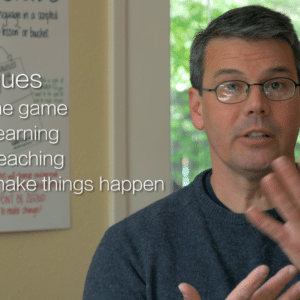You’ve found a “fluent fool” in your target skill; you dive right in after “fluency”, by picking a common, accessible, “same conversation”, then “start at the beginning” by “copycatting” everything they do.
“Art begins in imitation and ends in innovation” (Mason Cooley).
According to research over the past couple decades, humans (along with some other animals) are soft-wired with mirror neurons. This means that if you see another being doing or feeling something, your brain will fire with the same activity as if you were doing or feeling it yourself.
Author Jeremy Rifkin speaks more extensively about this in the RSAnimate video “the Empathic Civilization”.
If you’re observing a skill or a new situation, having those mirror neurons fire means you are halfway there to being able to perform that skill or navigate that situation yourself. You’ve already experienced it in your brain; you can absorb it further by copy-catting it in your body.
Copy-catting is a physical boost, an accelerator to your mirror neuron activity. Imitation seems to be a fundamentally human activity.
And yet we use the phrase “copy-cat” as an insult, to goad someone to stop their imitation. Is copy-catting a primitive activity, or an insightful, intelligent, empathic one? Perhaps it all depends on context.
Language acquisition is seen as an intellectual activity. If you speak many languages, people will label you “smart”, and if you struggle learning a single second language, you may feel “stupid”.
And yet, if all you did was focus purely on copy-catting a fluent native speaker (what they said, how they said it, in what situations they said it, and their body language), without any extra effort, you would eventually acquire proficiency in their language. This is in fact how languages are learned all the time, and one of the key elements in the success of “immersion” learning: you have no choice but to copy-cat.
What is intelligence? What is imitation? For the purposes of accelerating learning, is it worth differentiating between them?
We begin WAYK language games by telling players “all you have to do is copy-cat; don’t worry about learning or remembering anything.” This usually relaxes new player, even though copy-catting accurately and quickly seems to be a skill that takes some practice!
In this way we can make the bias against imitation work for us. Everyone knows “just” copying is easy, but learning is much harder! Great. Then let’s play a copy-cat game, instead of a learning game.
Because of mirror neurons, we begin with an ability and urge to imitate. In spite of this, when hunting fluency in a new skill, we may copy-cat poorly and hesitatingly. We can choose to improve our ability to copy-cat.
The more you copy-cat with gusto and commitment, the faster you will become fluent in your skill.
Fake it till you make it.
Introducing the technique
Short: “This is a game, and we mark every rule with this hand-sign [technique]. The first rule of the game is “Copy-cat”. Copy my voice, and my signs.”
Long: “You don’t have to remember or learn anything in this game, just “copy-cat”. This is a “copy-cat” game, not a learning game.”
Applying the technique to language acquisition
When hunting fluency in a skill, copy-cat early and often. Copy-catting is your primary route of skill acquisition.
• Copy-cat TQ Fluency by doing whatever your fluent fool does.
• TQ Signing not only encourages you to add a physical, mnemonic element with ASL, but also copying your fluent fool’s body language.
• TQ Overdo It through over-the-top imitation of the fluent speaker, like a celebrity impression.
• TQ Pull-me-through-it by anticipating my need to copy something; TQ Parrot by going first and letting me go second, TQ Sing-a-long Song by performing the skill simultaneously with me, and go TQ Just Behind me to affirm that I spoke correctly.
• TQ Mumble at first; close enough is good enough. Fake it till you make it!
• Remember you are always copycatting a specific TQ Accent; hunt the language of your fluent fool, not an abstract or theoretical standard of perfection. The fluent fool is always right.
But what about…?
“I learn better by just watching.” We hear this sometimes from new players. Of course, the first and best response is: “this is a copy-cat game, not a learning game'”! In our opinion, as game leaders, all human beings will boost their fluency through participatory copy-catting.
However, there can be some good reasons for making space for a player uncomfortable with copy-catting right away, due to fatigue or mistrust.
Also, depending on the culture, some players may actually be offended by the idea of copy-catting along with a game leader in a child-like way. They may associate it with punishment, compulsion, or judgement of their intellectual ability.
• If you have time and space, TQ Set-up TQ The Meadow for players who aren’t TQ Warm/Fed/Rested/Safe/Willing, or who are very TQ Full and need a deep rest from the game.
• Set-up a TQ Lunatic Fringe for players who feel comfortable copy-catting as long as they don’t have to be in the TQ Inner Circle.
• Filter the players you start with; copy-catting is a core driver for acceleration, so focus on playing with people who are TQ Warm/Fed/Rested/Safe/Willing.
• Just TQ You Go First, and don’t worry about whether or not copy-catting will work; because of mirror neurons, new players will quickly pick up the game. They usually can’t help it.







This is wonderfully encouraging, Willem! “Copy-cat” is a great technique for all forms of learning. Of course, this technique has been used throughout history by teachers of martial arts, yoga, dance, sports, and similar physical practices. But it works with mental practices, as well. It would be interesting to see the results of using Copy-Cat for math problems. I bet it would be quite effective.
I’m about to try it while teaching Test-Driven Development for the first time. I’ve converted the standard TDD demo into an I-do-you-do exercise. I’m hoping this will keep people more engaged, will increase retention, and will stimulate interesting questions.
Thanks Rob. “Copy-cat” is a pretty ancient way of learning, indeeed! And I’m excited too about the notion of applying it to skills such as math.
Your TDD experiment sounds intriguing. Please keep me posted. I wonder how many techniques you’re already applying (consciously or not) to the demo? I wonder how many more you could apply?
Wow, okay, I should proofread my own comments. Paragraph two, sentence one: Is this really my first time teaching TDD??? Well, first time this year… 😉
This is great Rob!
Applying WAYK to a variety of skills always gets my brain turning.
I also wonder how many other TQ you are using… 10? 50? Having the activity “Set-Up” as a copy-cat activity will increase the likely hood that everyone will be with you at every step. You will see when someone is having any issue because they will not copy at the same speed or grace… You will also be able to enlist the help of fellow students to “pull them through it”. The group will collectively “out” not the slow learners vs the geniuses but the “bite sized pieces” required to teach/learn this skill .
Sometimes people (teachers) comment to me that they are worried that a group will copy-cat along with such grace that clearly shows they already know the information perfectly… Teachers are worried that their students will get bored or feel like they are wasting their time. To that I say “How Fascinating!” At least now we all know that we are all on exactly the same page! And now that you have flown through the information you can all spend time thinking of the next steps and moving as a group into uncharted territory.
For me just the intention you are putting into your class means you are thinking about ways to improve your set-up. I wonder if your students are thinking about techniques they will bring to the class to make their time better spent and to pay forward to your (and your industries’) future classes? As the students enter the room will any of them make the exercise more “obviously”? Is there a best practice room set-up? Does entry music help “get this party started”? Is there perfect “get this party started” music for Test-Driven Development classes? Is it OZZY Osbourne? or Mozart?
Thank you, Evan! As I read this I pictured the possibilities happening during the TDD class. People are always paired up with a lab partner, which has multiple effects. E.g., pairs go silent when they’re stuck (I learned that from Diana’s and my friend Jim Shore). Pairs will be copying what I do, so that should create an interesting room dynamic, eh?
You got me thinking! Music, hmmm. Haven’t tried that yet. Any music with words draws me in (or tends to flush out all other thought from my brain), so I prefer instrumentals when working. Mozart would be ideal!
I like this one. It seems useful for lots of situations. Reminds me of when I worked with a Romanian lady and learned a smattering of words- I never tried to say the words “in English”- I just said them the way she did, same accent, same inflection. I never understood why someone would hear a person say something in an unfamiliar language, and then repeat it “in English”, as if they had just seen it written down and not HEARD IT SPOKEN with its proper sound.
You should hyperlink all the TQ references to their appropriate page. Less of a pain if you keep a word file or something with all the hyperlinks and you can just cut and paste them in as needed. It’d make this almost wikilike.
For that matter, why isn’t there a WAYKi?
And before you ask, no, I don’t want to put one up myself @_@
Thanks for the story!
Haha, we already do have a wiki, thanks to some hardworking WAYK players with more technical ability than me.
Check out http://wiki.whereareyourkeys.org. It’s really cool.
You can also keep updated on wiki developments (and other coolness) by reading the google group: http://groups.google.com/group/wayk
yrs,
Willem
Oh, hey, look at that! Good thinking, somebody ^_^ Guess I should have looked for that before spouting off.
Apparently the other intelligent species on the planet also use Copy-Cat:
http://www.presstv.ir/detail/160330.html